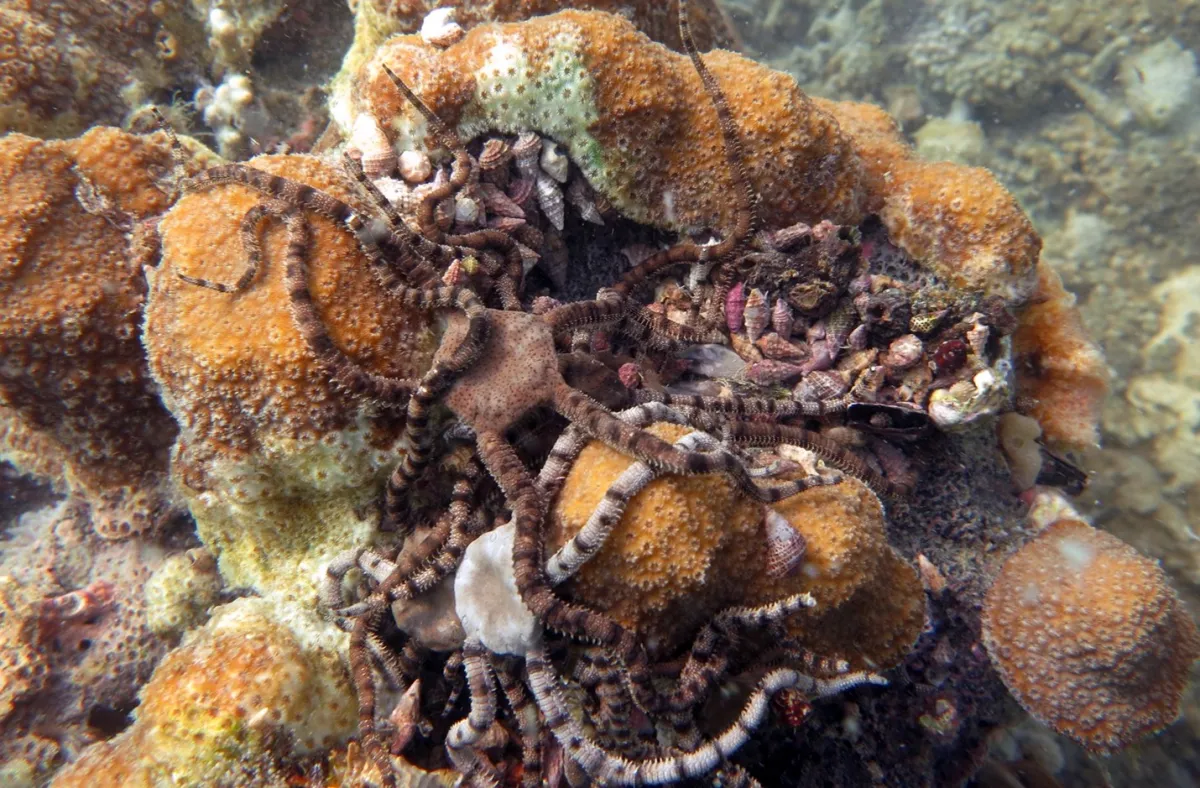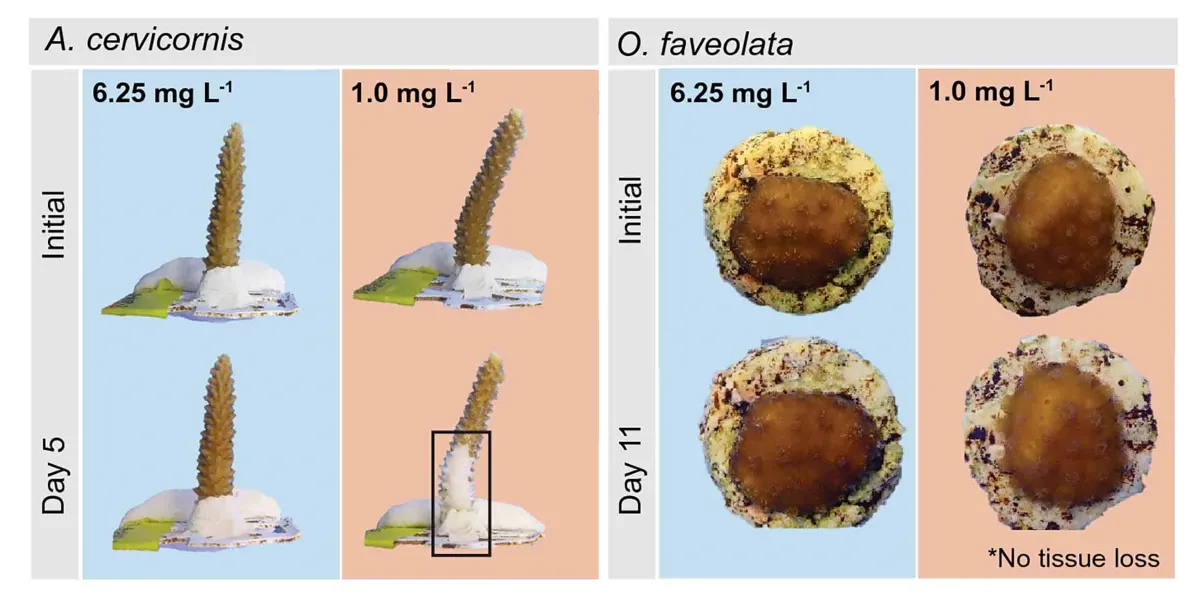
Search
Trouble Down Below
Trouble Down Below
Wildly differing responses of corals to low-oxygen environments offer clues for coral reef resilience in warming oceans.
By Maggie D. Johnson
Assistant Professor, Red Sea Research Center, KAUST
While a postdoctoral researcher at the Smithsonian Tropical Research Institute in Panama, I recall a remarkable, beautiful day tending a long-term experiment with my research assistant, Lucia Rodriguez. The water was flat calm, and the sun was shining on the turquoise reef water. Before starting our dive for work, Lucia and I sat on the boat for a few extra moments, appreciating how fortunate we were to be studying coral reefs in such a beautiful place.

When we got in the water our perspective on human impacts on coral reefs totally shifted, and my research interests took an unexpected turn.
Although the waters were serene above, below the surface the reef was an image of Armageddon. On that beautiful day in September 2017, Lucia and I jumped into the water and witnessed a deoxygenation event in progress—the depletion of dissolved oxygen from the water column.
Like a hard line at 9 feet of depth, we observed clear stratification: clear, oxygen-loaded water above, and cloudy, hypoxic water below. Fish schooled just above the oxygen-depleted water, not daring to descend further, and invertebrates like brittle stars and urchins had climbed to the tops of brain corals in a futile attempt to flee from the toxic, choking waters. Many of these animals normally hide during the day, so seeing them piled on top of each other at midday was shocking.

We returned to the research station and, with a team of colleagues, formulated a plan to collect data on the low-oxygen event. By pooling our collective knowledge, we were able to study everything from the oxygen levels in the water to the physical response of the corals and the microbes in the water. Our work was published last summer in Nature Communications.
This event opened my eyes to the impact that a deoxygenation event can have on a coral reef ecosystem. In a matter of days, virtually all of the corals below a depth of 9 feet had died, as well as any other invertebrates that couldn’t escape. To this day, those reefs remain completely decimated.

One of the most interesting aspects of this event, other than the occurrence of the event itself, was that not all corals in the hypoxic waters died. So that raised the question, what corals are able to survive hypoxic events, and why?
A Turn to the Tropics
Science has long been aware of hypoxic events and the potential for mass mortality and formation of “dead zones,” like in the Gulf of Mexico, but it has typically only been studied in cold-water habitats. Analogous events in the tropics, such as on coral reefs, have only risen to the forefront of reef science in the last few years. As a result, the effects of low-oxygen levels on corals and coral reefs have not been studied very well.
Though my earlier research was focused on the impacts of ocean acidification on Pacific coral reef species, after witnessing the hypoxic event as it happened in Panama, I wanted to learn more about how different species of corals might react to a variety of scenarios. These two areas are connected – by climate change.
Ocean acidification, which is the counterpart to ocean warming, is one result of the fossil fuel burning that releases carbon dioxide to the atmosphere. The ocean absorbs this additional carbon dioxide in the atmosphere, and the increased CO2 in seawater causes a cascading set of chemical reactions that ultimately lowers ocean pH, making it more acidic.

Certain types of marine life, like corals and other limestone-producing animals and plants, don’t do well when ocean water becomes more acidic. In my graduate work, I found that algae with limestone skeletons, much like corals, don’t grow as well under acidified conditions. Their shells, skeletons and other structures literally melt away.
Another impact of global warming caused by fossil fuel emissions is ocean deoxygenation. A vast amount of oxygen is dissolved in the ocean’s waters, and it is as essential for marine animals as for animals on land. But there are certain processes that deplete oxygen in seawater to levels that are dangerous and can be deadly for marine life.
Add to that the fact that warming decreases the capacity for water to hold oxygen; so warmer waters inherently have a lower oxygen content. And then there are short-duration events that can occur, sometimes referred to as a hypoxia event or a dead zone, when oxygen levels plummet to zero and conditions become anoxic, or completely depleted of oxygen. Nutrient pollution, wastewater discharge, and algal blooms are just a few things which, when combined with warming temperatures, can trigger a hypoxic event.

The Caribbean and Florida, two areas with many coral reefs but also dense human populations, are an ideal study ground for looking at the complex impacts of climate change and human-induced stress on coral reefs.
Working closely together with Dr. Andrew Altieri, a professor at the University of Florida, and Dr. Valerie Paul, director of the Smithsonian Marine Station (SMS), we secured funding from the National Oceanic and Atmospheric Administration's Coastal Hypoxia Research Program to study the effect of hypoxia on Florida’s coral reefs.
With a team led by myself and University of Florida PhD student Sara Swaminathan, we conducted our first set of experiments at SMS in Fort Pierce, Florida in the summer of 2019. Our goal was to grow different species of coral under hypoxic ocean conditions, simulating a deoxygenation event like we witnessed in Bocas del Toro in 2017.
We used species and genetic strains of corals from nurseries in the Florida Keys that grow corals for restoration initiatives. One thought behind our work was that by studying which species of corals do better or worse under deoxygenation, we might be able to provide information on which ones to use for restoration efforts.
The results from our 2019 experiment, recently published in Scientific Reports, gave us more insight into how different corals react to hypoxic stress. We know that some corals have a remarkable capacity to tolerate stressful environmental conditions, while others are more sensitive. The results of our study show that there are indeed species-specific tolerances to deoxygenation.

Our experiments showed that the staghorn coral (Acropora cervicornis), which also happens to be a primary candidate for coral reef restoration, is highly sensitive to deoxygenation. After just one day of growing under extreme low-oxygen conditions, Acropora corals started to lose tissue and showed signs of coral bleaching, an obvious sign of coral stress.
But under the same conditions, another reef-building species showed remarkable tolerance to deoxygenation. The mounding coral Orbicella faveolata survived in a low-oxygen environment for more than two weeks with no visible signs of stress.
These data provide a foundation for understanding what the impacts of ocean deoxygenation are for coral reefs and open the door for more complex studies aimed at determining why corals like Acropora are highly sensitive to deoxygenation—and at which locations they are the ideal choice for reef restoration.
Combined with observations we’ve made during field deoxygenation events in Panama, the results from our experiments can be used to inform and improve reef management and restoration efforts. For example, species that are highly tolerant to environmental change, like O. faveolata¸ may be the best choices when reef restoration is taking place in a location where oxygen conditions may vary. Conversely, A. cervicornis is likely a better choice for environments where there is a lot of ocean mixing and conditions stay well-oxygenated.
By using information from targeted lab experiments such as these, we can improve the success and efficiency of reef management and restoration strategies, thus increasing the likelihood for some reefs to survive under rapid environmental change.
Dr. Maggie Johnson is an assistant professor at the Red Sea Research Center at King Abdullah University of Science and Technology (KAUST), where she studies global change, ocean acidification and deoxygenation, community ecology, coral reefs, and algae. Dr. Johnson was a postdoctoral fellow at SMS from 2017-2019, supported by MarineGEO.